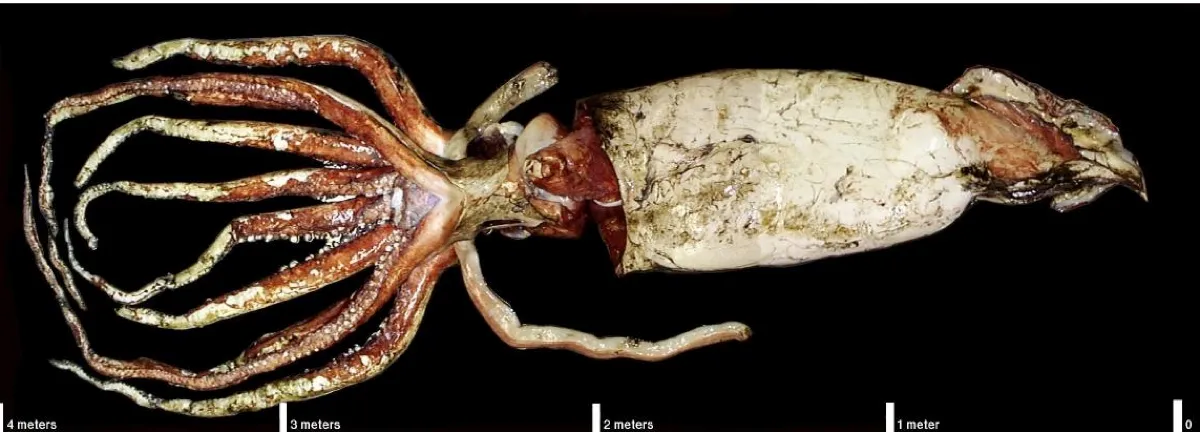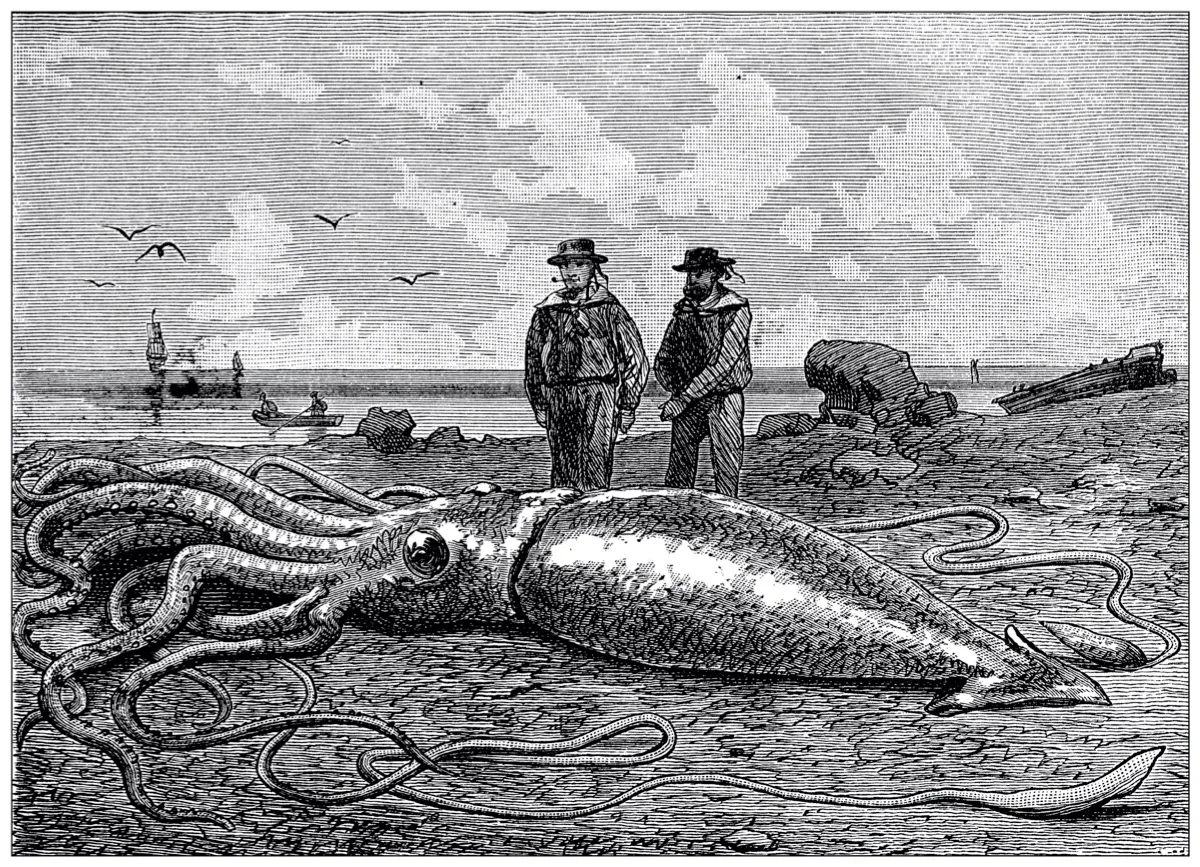As they live in the deep sea, giant squid are really hard to study. Much of our information has been pieced together from animals that have washed up on beaches or have been captured in fishing nets.
Most recently, on 16 August 2022, a giant squid washed up on Scarborough Beach in the Western Cape of South Africa. It measured more than four metres, although the massive invertebrates can reach a length of up to three times that. Experts from Iziko Museums collected samples from the squid for further study.
While modern techniques using deep-sea cameras have allowed us to capture them on film a handful of times, there is still much we don’t fully understand about their lifestyle and behaviour.

How big is a giant squid?
The giant squid is the longest cephalopod out there. That’s the class of molluscs that includes squid, cuttlefish and octopuses. While there have been claims of these ocean giants achieving lengths of 15 or 20 metres, in reality they reach a far more modest 12 to 13 metres. At least, that’s the size of the largest well-preserved individual that has been scientifically recorded. Who knows if there could be a bigger one out there?
The massive molluscs usually weigh around 200-280kg, according to scientific records, but there is one chonky individual that tipped the scales at 317.62kg.

What do giant squid look like?
Much like other squid species, the giant squid is characterised by a squishy elongated body, huge eyes, a beak, eight arms and two tentacles. Whereas most squid are pretty small, the giant squid is the supersized version.
When you look at a squid, it has a mantle, which is the ‘body’ of the squid where all the internal organs are located. The mantle has small fins at the end, used for moving around. Then there is the head, and finally the arms and tentacles. When scientists are establishing the size of a squid, they will take measurements of the mantle length as well as the total length. Mantle length can be considered a more reliable measurement, as the arms and tentacles can be stretched out like elastic, making the animal seem far longer than it really is.
How many tentacles does a giant squid have?
Cephalopod limbs seem to get the best of us in a tangle. Do they have arms, legs or tentacles? For a start, all cephalopods have appendages that extend from their head and encircle their beaks. Generally, arms have suckers along most of their length, while tentacles only have suckers at the end.
Octopuses have eight arms and no tentacles, whereas squid and cuttlefish have eight arms and two tentacles. Most male cephalopods will have a specialised arm to deliver sperm to the female. Giant squid are no different to their smaller relatives. They have eight arms and two longer tentacles.
But that’s not all. The suckers on the giant squid’s tentacles and arms measure between two and five centimetres in diameter. These suckers are lined with a sharp, serrated ring of chitin; this tough substance is also found in cephalopod beaks, as well the exoskeletons of insects. When the squid grabs its prey, the suckers’ jagged teeth, combined with suction, allow the squid to hang on tight so the animal cannot escape. It is not unusual to find circular scars around the head and mouth of sperm whales that have snacked on giant squid, and then had to deal with a many-armed meal that fights back.

When were giant squid discovered?
Aristotle talked about a large squid in Historia Animalium, while Pliny the Elder also described a huge squid with arms measuring more than nine metres in length. Tales of gargantuan sea monsters have been common for centuries, and then there is the Norse legend of the ferocious kraken.
It wasn’t until 1857 that the Danish zoologist Japetus Steenstrup compiled stories, reports of washed-up animals, and one very large squid beak to confirm that an enormous squid indeed lurked in the ocean. He named it Architeuthis dux.
Over the years, the number of species of giant squid has been debated. Then in 2004, one nearly complete specimen was accidentally caught by a fishing trawler off the Falkland Islands. The body was immediately frozen and transferred to the Natural History Museum, London, for study and preservation. DNA samples obtained from this specimen, named Archie, helped scientists confirm that there is only one species of giant squid, Architeuthis dux.
What do giant squid eat?
By analysing the stomach contents of dead giant squid, scientists can establish what their recent meals were. It appears that they like to eat deep-sea fish and other squid species. As for cannibalism? We aren’t sure.
They grab the prey with their two feeding tentacles, and draw it towards their sharp, powerful beak, before shredding the unfortunate animal with their radula. The radula is tongue-like organ covered in tiny, toothed structures and is found in many mollusc species, including the humble garden snail. It is used to scrape or rasp at food, whether that’s algae, leaves or flesh.
What eats giant squid?
One perk of being a giant, intelligent animal is that not many animals can eat you. You’re big enough and smart enough to overpower or outwit anything that fancies having a go. Nonetheless, Mr Squiddy isn’t completely undefeatable. Sperm whales and sleeper sharks are known to feed on adult giant squid, while juveniles are a little more vulnerable and may be attacked by smaller whales and sharks, as well as other squid.
Where do giant squid live?
Their inaccessible habitat has made them hard to study, but data gained from sperm whale diving behaviour and trawled specimens suggests they live at depths of 300 to 1,000 metres – yet it is completely possible that they could live even deeper. They are widespread around the world’s oceans, but tend to avoid tropical and polar regions.
Read more about squid:
- Smart material made from squid teeth a possible plastic alternative
- How do squid survive extreme water pressure in the deep sea?
How long do giant squid live?
Giant squid, like other cephalopods, have an organ called a statocyst, which helps them with orientation and motion. Within the statocyst is a mineralised structure called a statolith. Scientists can use these statoliths to determine the age of cephalopods by counting the statolith’s growth rings – similarly to how you would calculate the age of a tree. Researchers have established that giant squid can live to about five to six years old.
"Most squid live shorter lives, some as short as six months, most about a year,” says squid biologist Dr Sarah McAnulty. “The longest lived cephalopod I can think of is Graneledone, a deep-sea octopus, and we're not even totally sure how long they live. It's just a guess that they live quite a while based on how long they brood their eggs – 4.5 years!
"Some deep-sea animals live an obscenely long time, like the Greenland shark. Five to six years is pretty old for a cephalopod. While it's not as old as that Greenland shark, it's still in line with deep animals living longer than shallow animals.”

How smart is a giant squid?
Cephalopods can problem-solve and are capable of opening containers to extract food, while captive octopuses will need enrichment in their tanks to keep them occupied. Scientists are therefore incredibly interested in studying the ‘intelligence’ of these animals.
We do know that giant squid have a large brain and a complex nervous system, just like other cephalopods. While we haven’t managed to keep any giant squid specimens alive in captivity in order to study them, research conducted in 2020 looked at the giant squid genome and found that it contains around 135 protocadherin genes.
In vertebrates, it is thought that these genes play an important role in wiring up the brain, but they are typically not found large numbers in invertebrates. This research suggests that they could play a similar developmental role in the giant squid, hinting at a complex and highly evolved brain.
Read more about the deep sea:
- Deep-sea mountains: Earth's unexplored ecosystems that are teeming with life
- Mysteries of the deep sea: 5 burning questions about Earth's final frontier
How big is a giant squid’s eye?
A giant squid has an eye measuring up to 27cm, making it the largest peeper of any animal (although colossal squid eyes may be bigger). To put it into context, that’s about the size of a dinner plate. According to Te Papa museum in Wellington, the giant squid’s eyes are placed on the side of its head, allowing it to see forwards and behind. The colossal squid’s eyes face forwards, giving it binocular vision, which allows it to judge distances.
While large eyes will allow the squid to make the most of any meagre light that reaches the ocean depths, there is another theory as to why they have evolved such massive eyes. A paper published in 2012 in the journal Current Biology suggested that the huge eyes allow the giant squid to detect sperm whales –their main predator –at depth. As the whales move through the water, they disturb plankton and other smaller organisms, causing flashes of bioluminescence. If the giant squid can detect these flashes of light in enough time, they can make a rapid escape.

What are colossal squid?
Giant squid, colossal squid… nope, scientists aren’t just getting creative with their adjectives, there really is a different species of squid called the colossal squid. While the colossal squid is a bit shorter than the giant squid, measuring up at about 10m, it’s far heavier, reaching a weight of 495kg.
Researchers at Te Papa museum have measured the beak of a colossal squid that they have on display at 42.5mm. Colossal squid beaks found in the stomachs of sperm whales have been measured at 49mm, so the scientists think that bigger colossal squid must be lurking in the ocean’s depth.
When was the first living giant squid photographed?
It wasn’t until 2004 that the first giant squid was photographed while still alive. Zoologist Dr Tsunemi Kubodera and whale watcher Kyoichi Mori went to a known sperm whale hunting ground off the Ogasawara Islands, south of Japan. They dropped a baited line and a camera to a depth of 900m and managed to successfully photograph the squid.
The animal became caught on the line, and when it broke free, it left a tentacle behind. Genetic analysis confirmed the tentacle was from a giant squid, and the researchers say that once the tentacle was back on the boat, “It was still functioning, with the large suckers of the tentacle club repeatedly gripping the boat deck and any offered fingers.”
A few years later, in 2012, scientists hit the jackpot. Kubodera once again travelled to the Ogasawara Islands with deep-sea explorer Edith Widder, who had developed a special camera called Medusa, which uses a low-light system to avoid scaring the squid away. They dropped Medusa to 700 metres and captured a giant squid on film for the first time.
Later expeditions using Medusa filmed a squid off the coast of the US, as seen in this video.
About our expert
Dr Sarah McAnulty (@SarahMackAttack) is a squid biologist and science communicator.
Read more about cephalopods:
